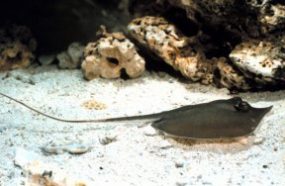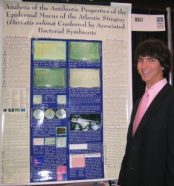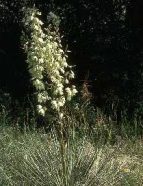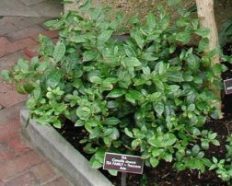Nature’s medicines
Projects by young scientists show how plants and animals in nature can be a source of new medicines.
By Emily Sohn
You would probably never think to slap a stingray on a scraped knee. Eighteen-year-old Ben Powell, however, has found compounds on a stingray’s skin that may help fight infections.
 |
|
An Atlantic stingray in an aquarium.
|
| NOAA Photo Library |
Several clues had pointed to the possibility that there might be something special about stingray skin. Atlantic stingrays, for example, can deal with microbes in both fresh water and seawater. Sharks, which have a similar type of skin, sometimes nibble on each other but don’t appear to get skin infections.
“I figured something had to be going on,” Ben says. He’s a senior at Sarasota High School in Sarasota, Fla.
Ben presented his research results last month at the 2005 Intel International Science and Engineering Fair (ISEF) in Phoenix, Ariz. He was one of a record 1,447 high school students from 45 countries who participated in the fair. The young scientists competed for more than $3 million in scholarships, trips, and other prizes.
Slimy stuff
Ben’s project was one of several at ISEF that focused on medical treatments that may be lurking in nature.
An internship at Mote Marine Laboratory near his home inspired Ben’s interest in stingrays. When he started working there 2 years ago, he spent most of his time feeding the aquarium’s sharks, skates, and stingrays.
Eventually, Ben started talking to doctors at the lab. They were conducting medical research on the animals. Among the things that Ben learned was that young trout and salmon produce chemicals that appear to fight cancer.
Ben wondered whether stingrays might also produce chemicals that have a beneficial effect. He had noticed that stingrays rarely get sick, even though they live in an environment full of disease-causing bacteria. He hypothesized that stingrays might have microbe-fighting powers.
 |
|
Ben Powell and his stingray project.
|
| Emily Sohn |
To test his idea, Ben studied mucus that had been scraped off the skin of stingrays living at the aquarium. Through a series of experiments, he discovered several proteins in the mucus that killed bacteria.
This summer, Ben plans to see whether a stingray’s mucous proteins can kill bacteria among a mammal’s blood cells. The ultimate goal would be to copy stingray biology to produce new types of antibiotic medicines for people.
Down with swelling
The idea that stingray mucus could harbor medicine may sound unusual, but pursuing unusual ideas is one mark of a successful researcher, says Kels Phelps. He’s a 17-year-old junior at Butte High School in Butte, Montana.
“In the search for new medicines,” Kels says, “it’s important to cover all the bases.” Like Ben, Kels found a possible source for medicine not in a drugstore, but in nature.
For his project, Kels studied a plant called Yucca glauca, which grows naturally in Montana. The Cheyenne Indians have long used yucca plants as medicine. They believe yucca reduces inflammation, or swelling, just as Advil, Aleve, and other common medications do. Kels was interested in investigating the chemistry behind the Indian claim.
 |
|
The soapweed yucca plant (Yucca glauca) may have value for reducing swelling after an injury.
|
| Clarence A. Rechenthin. Courtesy of USDA NRCS Texas State Office. |
Inflammation is what happens to your ankle after you twist it or to your arm after an allergic reaction to a bee sting. You probably feel pain and notice puffiness in the area of the injury. These signs of injury typically go away after a few days.
Inflammation that doesn’t go away is a major cause of discomfort and complications in a number of serious diseases, including multiple sclerosis (MS), arthritis, and Huntington’s disease. In these cases, certain enzymes in the body become overactive and cause excessive inflammation.
Kels began by separating yucca plants into their parts: roots, stems, and flowers. He soaked the parts in a special solution. Then, he extracted promising chemical compounds from the mixtures. His lab experiments showed that these compounds were good at fighting certain types of microbes.
 |
|
Kels Phelps and his yucca plant project.
|
| Emily Sohn |
“I took a step toward proving that yucca has anti-inflammatory properties,” Kels says. His work also showed him how much nature has to offer and how little we know about the world around us.
“As far as the vast number of plants out there and the small amount of research done on them,” he says, “there’s a huge, untapped resource for the next generation of medicines.”
Green tea
Iddoshe Hirpa tapped into this enormous resource for her project on green tea. She had heard about possible health benefits and anticancer properties of the green tea plant (called Camellia sinensis), and she wanted to learn more.
 |
|
A tea bush.
|
| www.wikipedia.org |
“Both my parents are from Africa,” says the 15-year-old 10th grader from duPont Manual Magnet High School in Louisville, Kentucky. “People there don’t have access to all the medicines we have here.”
Iddoshe worked with a chemical called EGCG, which occurs naturally in green tea. Past research had suggested that EGCG fights inflammation.
For her experiments, Iddoshe applied three different concentrations of EGCG to proteins that cause inflammation in the brains of people who suffer from MS. She found that the highest concentration of EGCG she used destroyed the most proteins. This result confirms, she says, that green tea really can reduce inflammation.
 |
|
Iddoshe Hirpa and her green tea project.
|
| Emily Sohn |
Iddoshe was so impressed by her results that she started buying and drinking green tea (which she loads with milk and sugar to make it taste good). Lately, though, she’s fallen out of the habit. “I feel even worse now because I know how good it is for you,” she says. “It’s so embarrassing.”
Even as Iddoshe struggles to make green tea part of her daily routine, she has learned an important lesson from her work.
“It’s a wakeup call to people,” she says. The more we destroy nature, the more we destroy possibilities for healing our own problems. “There are so many things nature could give us.”
Achievements
ISEF projects show just how much students can achieve when they pursue a passion, says Intel’s Craig Barrett. Intel sponsored the competition along with more than 70 other organizations, government agencies, universities, and corporations.
“I have faith this new generation of young scientists and engineers will help cure diseases, protect the environment, and develop breakthrough technologies that will one day change the world,” Barrett says.
If Ben, Kels, and Iddoshe are any indication, the next generation is already partway there.
Going Deeper:







